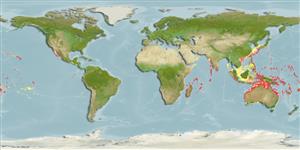Common names from other countries
Environment: milieu / climate zone / depth range / distribution range
Ökologie
seewasser riff-verbunden; tiefenbereich 0 - 82 m (Ref. 57178), usually 0 - 15 m (Ref. 90102). Tropical
Indo-Pacific: from East Africa and the Red Sea to French Polynesia; north to Japan and south to Australia.
Size / Gewicht / Alter
Maturity: Lm ? range ? - ? cm
Max length : 3.5 cm SL Männchen/unbestimmt; (Ref. 37816)
Kurzbeschreibung
Morphologie | Morphometrie
Rückenflossenstacheln (insgesamt): 9; Rückenflossenweichstrahlen (insgesamt): 9; Afterflossenstacheln 2; Afterflossenweichstrahlen: 8; Wirbelzahl: 24. This species is distinguished by the following characters: usually 8-12 pored lateral-line scales and 13-15 gill rakers and rudiments; body scales margins uniform to pale edging; body mottled brownish with 5 darker irregular bars, the first anterior to origin of first dorsal fin, the second bar from posterior half of first dorsal fin through posterior half of pelvic fin, the third narrow bar between soft dorsal and soft anal fins, the fourth on caudal peduncle, and the fifth at base of caudal fin; axil of pectoral fin with a whitish spot; 3 whitish basicaudal spots partially in darkish basicaudal bar; whitish spot behind posterior base of soft dorsal fin; second dorsal fin, anal fin and caudal fin pale with darkish banding (Ref. 93673).
Nocturnal species; occurs inshore (Ref. 7300). Enters estuaries and quiet coastal bays, usually on mud or silty substrate with algae-rock outcrops or isolated soft corals (Ref. 48635). Solitary or in small groups (Ref 90102).
Life cycle and mating behavior
Geschlechtsreife | Fortpflanzung | Ablaichen | Eier | Fecundity | Larven
Are mouthbrooders (Ref. 240). Distinct pairing during courtship and spawning (Ref. 205).
Fraser, T.H. and J.E. Randall, 2011. Two new species of Foa (Apogonidae) from the Pacific Plate, with redescriptions of Foa brachygramma and Foa fo. Zootaxa 2988:1-27. (Ref. 93673)
IUCN Rote Liste Status (Ref. 130435)
CITES (Ref. 128078)
Not Evaluated
Bedrohung für Menschen
Harmless
Nutzung durch Menschen
Mehr Information
Alter/GrößeWachstumLänge-GewichtLänge-LängeLängenhäufigkeitenMorphometrieMorphologieLarvenLarven Pop.Dyn.RekrutierungDichte
ReferenzenAquakulturAquakultur ProfilZuchtlinienGenetikElectrophoresesVererbbarkeitKrankheitenVerarbeitungMass conversion
PartnerBilderStamps, Coins Misc.LauteCiguateraGeschwindigkeitSchwimmstilKiemenoberflächeOtolithsGehirngrößeSehfähigkeit
Tools
Zusatzinformationen
Download XML
Internet Quellen
Estimates based on models
Preferred temperature (Ref.
115969): 24.2 - 29.2, mean 28 (based on 2296 cells).
Phylogenetic diversity index (Ref.
82804): PD
50 = 0.5039 [Uniqueness, from 0.5 = low to 2.0 = high].
Bayesian length-weight: a=0.01479 (0.00690 - 0.03171), b=3.09 (2.91 - 3.27), in cm Total Length, based on LWR estimates for this (Sub)family-body shape (Ref.
93245).
Trophic level (Ref.
69278): 3.2 ±0.5 se; based on size and trophs of closest relatives
Widerstandsfähigkeit (Ref.
120179): hoch, Verdopplung der Population dauert weniger als 15 Monate. (Preliminary K or Fecundity.).
Fishing Vulnerability (Ref.
59153): Low vulnerability (10 of 100).
